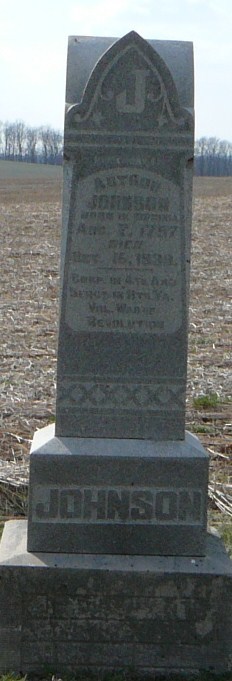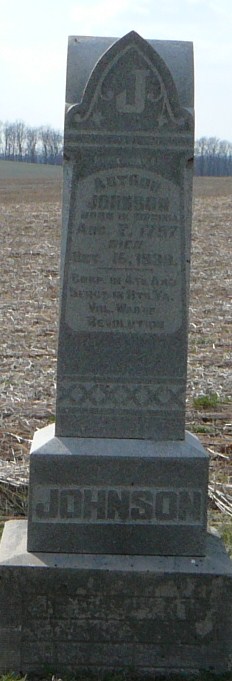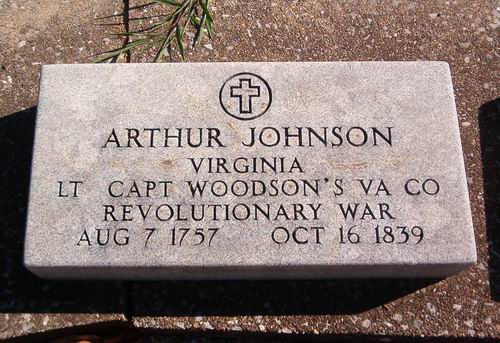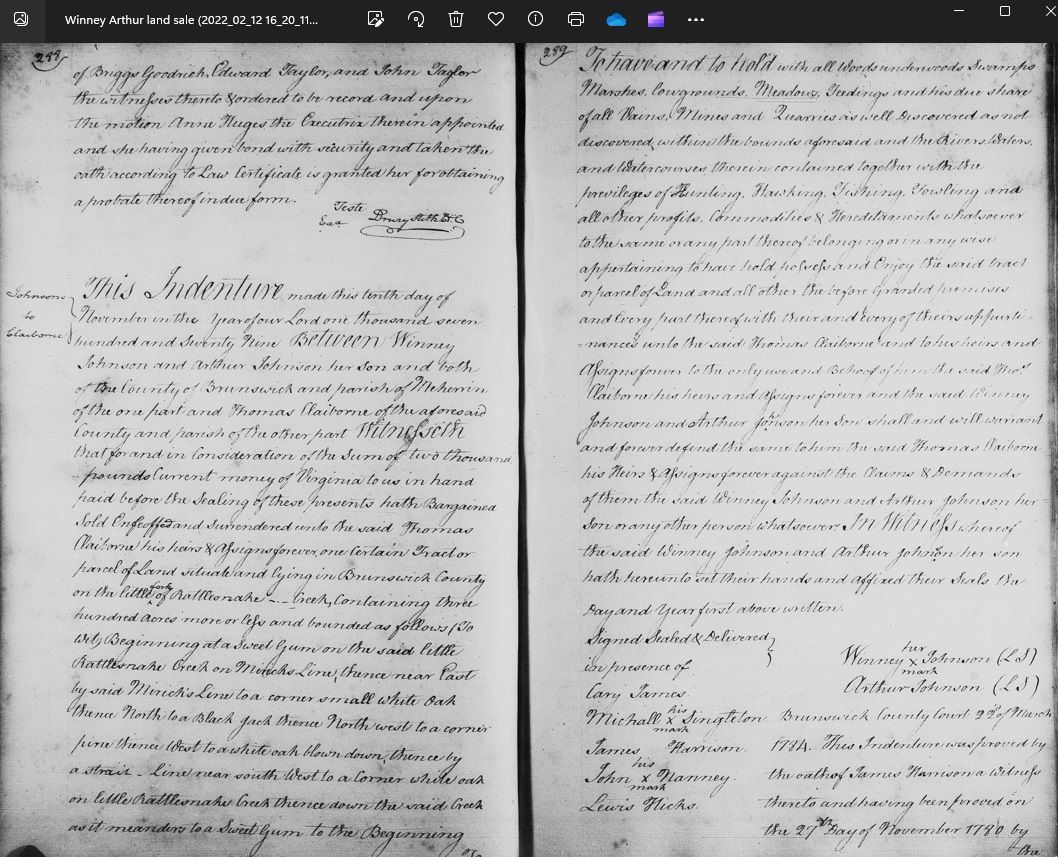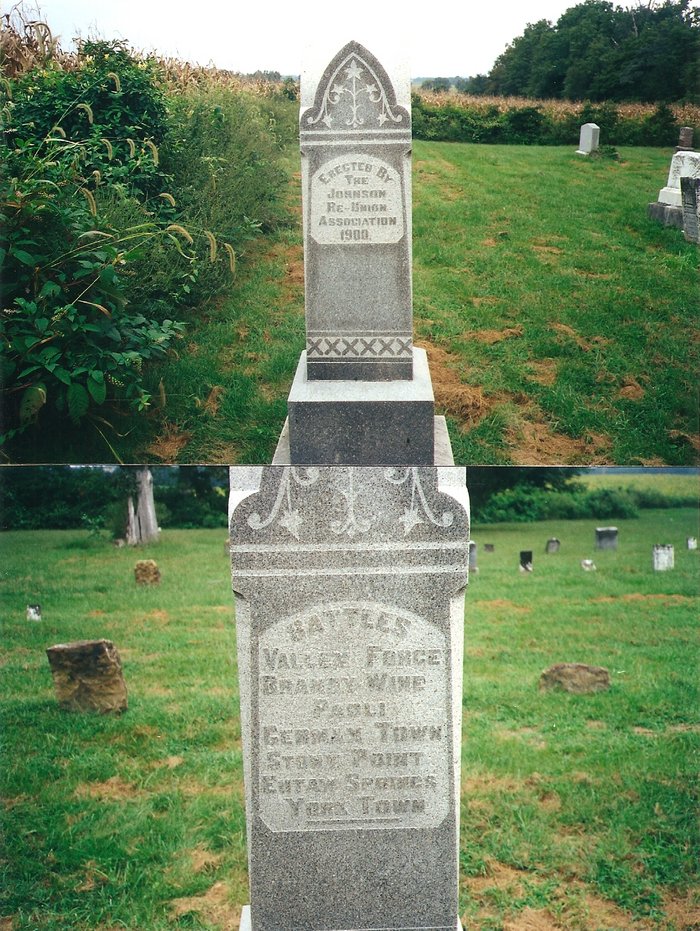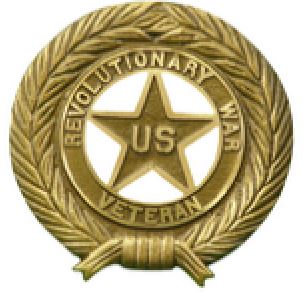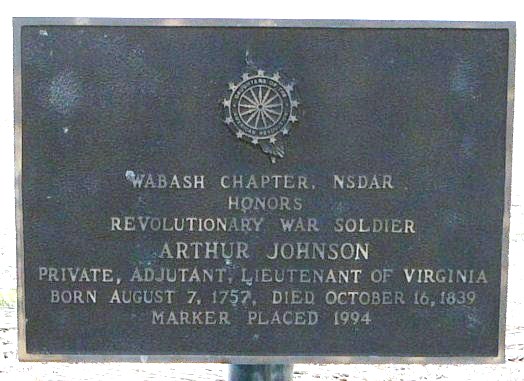*Dec 9, 1775 Found in Battle of the Great Bridge near Great Bridge, Virginia under Stevens who commanded the Culpepper Minutemen.
*Jan 1776 Johnson fought at the Siege of Norfolk .
*Sept 1776, Williamsburg, Virginia. Discharged from his service under Stevens.
*1776 Reenlisted later that fall. Served as Adjutant to VA Volunteers and LT Volunteer Militia.
*Served as a Lieutenant in a Company of Volunteer Militia under the command of Col Thomas Branham and Gen. Nathaniel Greene.
*Jan 2, 1779 Brunswick County, Virginia. Marriage to Lucy Harmon.
*Oct 1839- Arthur was buried on Robert Cates farm (son in law).
*Sept. 12, 1898, Arthur's remains were exhumed by his descendants and reinterred in the Johnson Cemetery next to his wife Lucy Harmon Johnson in White Co., Ill., four and one half miles east of Enfield, where a beautiful monument has been erected commemorating his services as a soldier in the war of the Revolution.
He served as corporal in Capt. James Knox's company, Col. Abraham bowman's Eighth Regiment, from May 1776 to April 30, 1777. He again enlisted January 2, 1777 for three years. He was in Capt. Thomas Berry's company, Eighth Regiment, serving as sergeant; also with Capt. Abraham Kirkpatrick's company, same regiment. He was acting sergeant in Capt. William Crogan's company, Fourth Regiment, and in May 1779, in Capt. Leonard Cooper's company with Col. John Nevill's Fourth Regiment. After the war he removed to Kentucky, and from there to Gibson County, Indiana, and later to White County, Illinois, where he died October 16, 1839, and was buried in the Seven Mile Prairie cemetery, four miles north of Enfield. A monument has been erected by descendants, upon which is inscribed his military record
Enlisted Reg Army 1775 according to penison papers. Served 1 year 2nd VA Regiment as PVT. Discharged Sept 1776, Williamsburg, VA. Reenlisted later that fall. Served as Adjutant to VA Volunteers. Went on to serve as LT, Volunteer Militia. 1780 was LT in VA Regiment in South Carolina. 1781 he was discharged. National Archive Pension Papers Arthur Johnson, National Society Daughters of the American Revolution and copies of Johnson Family Bible.
Arthur A. Johnson served as Sergeant in Capt. Cooper's Company, 4th Virginia Regiment commanded by Colonel John Nevill in the Revolutionary War. He enlisted January 3rd, 1777 as Sergeant in Captain James Knox's Company, 8th Virginia Regiment to serve 3 years. His name last appears on roll for the month of November 1779.
Taken from the tombstone in White County, IL. where he was buried are 7 major battles in which he fought:
1. Valley Forge - Dec. 19, 1777, to June 19, 1778 - The conditions which the soldiers camped at Valley Forge had to endure cannot be overlooked. As said by Albigence Waldo in his diary, a surgeon at Valley Forge, conditions could have been described as, ?Poor food - hard lodging - cold weather - fatigue - Nasty cloths - and nasty Cookery.? Throughout his diary, Waldo wrote about the little food and clothes the soldiers had, all of the sickness, and the lack of the necessities of life. Out of the 10,000 soldiers, more than 2,000 died. The rest were left battling the cold, hunger, and fatigue of Valley Forge.
2. Brandywine - September 11, 1777 - the largest engagement of the Revolutionary War, fought on September 11, 1777, between the Continental Army led by General George Washington and the British forces headed by General William Howe.
3. Paoli - September 21, 1777 - 53 Americans were killed and over 100 wounded in Grey's lightning raid. The use of the bayonet coupled with the notion that the British stabbed or burned the Americans who tried to surrender, made martyrs of those maimed and killed at Paoli. For the rest of the war, the British lived in fear that Wayne's troops would try to avenge the affair that came to be know as the Paoli Massacre.
4. Germantown - Oct 4, 1777 - It is said that Germantown was a profound influence in convincing the French Court that the American cause was worth supporting by a declaration of war on England. The French were more impressed by the ability of the Americans to raise their army and deliver an attack on the British than by its lack of success. The noteworthy feature of the battle was the failure of the British commanders to exploit their battlefield success by pursuing and destroying the defeated American force.
5. Eutaw Springs - At Eutaw Springs, Greene, with around 2,200 men, came across a British camp under Lieutenant-Colonel Alexander Stewart. The American force formed up in two lines, with the militia in the front line, North Carolina, Maryland and Virginia regulars in the second. A British bayonet charge broke the center of the American first line. The situation was temporarily restored by the North Carolina Continentals until they too were broken by a British charge, but the Virginia and Maryland troops were sent into the breach and managed to force the British to fall back in some disorder.
6. Stoney Point - The barrage was less than one hour and was conclusive evidence to them that the British at Stony Point had succeeded in repelling the American offensive. After establishing control of the site, an American artillery detachment used the guns of Stony Point to bombard Verplanck's Point. The American victory at Stony Point was the last major battle in the North, and also boosted American morale. Clinton's plan to defeat the Continentals and end the war had failed. Three days later, Washington abandoned Stony Point because he could not spare the men to continue to occupy the fort. He also knew it could not be defended against the combined might of the British army and navy.
7. Yorktown - a decisive victory by a combined assault of American forces led by General George Washington and French forces led by General Comte de Rochambeau over a British Army commanded by General Lord Cornwallis. It proved to be the last major land battle of the American Revolutionary War, as the surrender of Cornwallis?s army (the second major surrender of the war, the other being Burgoyne's surrender at the Battle of Saratoga) prompted the British government to eventually negotiate an end to the conflict.
**EARLY WHITE SETTLER: The first white settlers came to White County 1807 to 1809. The first settlements were near the Little Wabash River and Big Prairie, one of the numerous prairies in the county. These families; Hanna, Land, Hay, Williams, Calvert, Ratcliff, Holderby, Robinson, Stewart, Pollard, Johnson among others, typically had spent time in the Carolinas, Kentucky or Tennessee before moving into Illinois, and most were of Scots-Irish descent. Many came through the land office at Shawneetown, Illinois, which was a port for flatboats which traveled the Ohio River.
Other early settlements were Grayville, located at the mouth of Bonpas Creek and the Wabash River, settled by the Gray family around 1810; Phillipstown, on the bluffs above the Wabash and Fox River floodplain; and New Haven, which was home to a brother of Daniel Boone around 1818. Old Sharon Church (Presbyterian), located near the later village of Sacramento, was organized around 1816, and the village of Seven Mile Prairie was established a few miles north of the church in the 1830s. The parents of longtime Abraham Lincoln girlfriend Ann Rutledge were part of this group, along with families named McArthy, Miller, McClellan, Pollard, Storey, Fields and Johnson.
∼* Lieutenant
*Dec 9, 1775 Found in Battle of the Great Bridge near Great Bridge, Virginia under Stevens who commanded the Culpepper Minutemen.
*Jan 1776 Johnson fought at the Siege of Norfolk .
*Sept 1776, Williamsburg, Virginia. Discharged from his service under Stevens.
*1776 Reenlisted later that fall. Served as Adjutant to VA Volunteers and LT Volunteer Militia.
*Served as a Lieutenant in a Company of Volunteer Militia under the command of Col Thomas Branham and Gen. Nathaniel Greene.
*Jan 2, 1779 Brunswick County, Virginia. Marriage to Lucy Harmon.
*Oct 1839- Arthur was buried on Robert Cates farm (son in law).
*Sept. 12, 1898, Arthur's remains were exhumed by his descendants and reinterred in the Johnson Cemetery next to his wife Lucy Harmon Johnson in White Co., Ill., four and one half miles east of Enfield, where a beautiful monument has been erected commemorating his services as a soldier in the war of the Revolution.
He served as corporal in Capt. James Knox's company, Col. Abraham bowman's Eighth Regiment, from May 1776 to April 30, 1777. He again enlisted January 2, 1777 for three years. He was in Capt. Thomas Berry's company, Eighth Regiment, serving as sergeant; also with Capt. Abraham Kirkpatrick's company, same regiment. He was acting sergeant in Capt. William Crogan's company, Fourth Regiment, and in May 1779, in Capt. Leonard Cooper's company with Col. John Nevill's Fourth Regiment. After the war he removed to Kentucky, and from there to Gibson County, Indiana, and later to White County, Illinois, where he died October 16, 1839, and was buried in the Seven Mile Prairie cemetery, four miles north of Enfield. A monument has been erected by descendants, upon which is inscribed his military record
Enlisted Reg Army 1775 according to penison papers. Served 1 year 2nd VA Regiment as PVT. Discharged Sept 1776, Williamsburg, VA. Reenlisted later that fall. Served as Adjutant to VA Volunteers. Went on to serve as LT, Volunteer Militia. 1780 was LT in VA Regiment in South Carolina. 1781 he was discharged. National Archive Pension Papers Arthur Johnson, National Society Daughters of the American Revolution and copies of Johnson Family Bible.
Arthur A. Johnson served as Sergeant in Capt. Cooper's Company, 4th Virginia Regiment commanded by Colonel John Nevill in the Revolutionary War. He enlisted January 3rd, 1777 as Sergeant in Captain James Knox's Company, 8th Virginia Regiment to serve 3 years. His name last appears on roll for the month of November 1779.
Taken from the tombstone in White County, IL. where he was buried are 7 major battles in which he fought:
1. Valley Forge - Dec. 19, 1777, to June 19, 1778 - The conditions which the soldiers camped at Valley Forge had to endure cannot be overlooked. As said by Albigence Waldo in his diary, a surgeon at Valley Forge, conditions could have been described as, ?Poor food - hard lodging - cold weather - fatigue - Nasty cloths - and nasty Cookery.? Throughout his diary, Waldo wrote about the little food and clothes the soldiers had, all of the sickness, and the lack of the necessities of life. Out of the 10,000 soldiers, more than 2,000 died. The rest were left battling the cold, hunger, and fatigue of Valley Forge.
2. Brandywine - September 11, 1777 - the largest engagement of the Revolutionary War, fought on September 11, 1777, between the Continental Army led by General George Washington and the British forces headed by General William Howe.
3. Paoli - September 21, 1777 - 53 Americans were killed and over 100 wounded in Grey's lightning raid. The use of the bayonet coupled with the notion that the British stabbed or burned the Americans who tried to surrender, made martyrs of those maimed and killed at Paoli. For the rest of the war, the British lived in fear that Wayne's troops would try to avenge the affair that came to be know as the Paoli Massacre.
4. Germantown - Oct 4, 1777 - It is said that Germantown was a profound influence in convincing the French Court that the American cause was worth supporting by a declaration of war on England. The French were more impressed by the ability of the Americans to raise their army and deliver an attack on the British than by its lack of success. The noteworthy feature of the battle was the failure of the British commanders to exploit their battlefield success by pursuing and destroying the defeated American force.
5. Eutaw Springs - At Eutaw Springs, Greene, with around 2,200 men, came across a British camp under Lieutenant-Colonel Alexander Stewart. The American force formed up in two lines, with the militia in the front line, North Carolina, Maryland and Virginia regulars in the second. A British bayonet charge broke the center of the American first line. The situation was temporarily restored by the North Carolina Continentals until they too were broken by a British charge, but the Virginia and Maryland troops were sent into the breach and managed to force the British to fall back in some disorder.
6. Stoney Point - The barrage was less than one hour and was conclusive evidence to them that the British at Stony Point had succeeded in repelling the American offensive. After establishing control of the site, an American artillery detachment used the guns of Stony Point to bombard Verplanck's Point. The American victory at Stony Point was the last major battle in the North, and also boosted American morale. Clinton's plan to defeat the Continentals and end the war had failed. Three days later, Washington abandoned Stony Point because he could not spare the men to continue to occupy the fort. He also knew it could not be defended against the combined might of the British army and navy.
7. Yorktown - a decisive victory by a combined assault of American forces led by General George Washington and French forces led by General Comte de Rochambeau over a British Army commanded by General Lord Cornwallis. It proved to be the last major land battle of the American Revolutionary War, as the surrender of Cornwallis?s army (the second major surrender of the war, the other being Burgoyne's surrender at the Battle of Saratoga) prompted the British government to eventually negotiate an end to the conflict.
**EARLY WHITE SETTLER: The first white settlers came to White County 1807 to 1809. The first settlements were near the Little Wabash River and Big Prairie, one of the numerous prairies in the county. These families; Hanna, Land, Hay, Williams, Calvert, Ratcliff, Holderby, Robinson, Stewart, Pollard, Johnson among others, typically had spent time in the Carolinas, Kentucky or Tennessee before moving into Illinois, and most were of Scots-Irish descent. Many came through the land office at Shawneetown, Illinois, which was a port for flatboats which traveled the Ohio River.
Other early settlements were Grayville, located at the mouth of Bonpas Creek and the Wabash River, settled by the Gray family around 1810; Phillipstown, on the bluffs above the Wabash and Fox River floodplain; and New Haven, which was home to a brother of Daniel Boone around 1818. Old Sharon Church (Presbyterian), located near the later village of Sacramento, was organized around 1816, and the village of Seven Mile Prairie was established a few miles north of the church in the 1830s. The parents of longtime Abraham Lincoln girlfriend Ann Rutledge were part of this group, along with families named McArthy, Miller, McClellan, Pollard, Storey, Fields and Johnson.
∼* Lieutenant
Bio by: W. Pollard
Inscription
VIRGINIA
LT CAPT WOODSON'S VA CO
REVOLUTIONARY WAR
Family Members
Advertisement
Explore more
Sponsored by Ancestry
Advertisement
